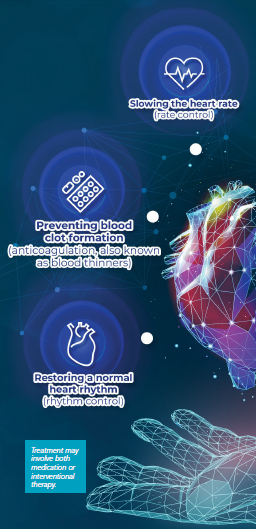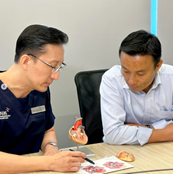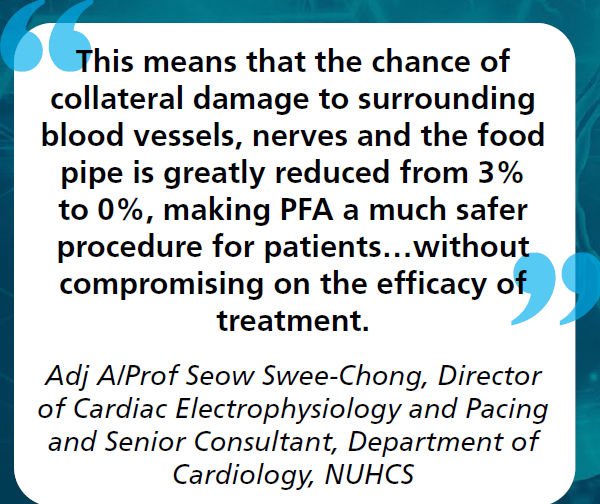A Safer, Better Approach For Heart Rhythm Disorder
A novel & safe treatment technique, Pulsed Field Ablation (PFA) treats Atrial Fibrillation without causing collateral damage to the body
PULSE Issue 42 | February 2024

Did you know that those with
Atrial Fibrillation (AF) are five times more likely to suffer from a stroke? Affecting approximately 1 in 100 people, AF is the most common heart rhythm disorder in the world and afflicts 2.6% of men and 0.6% of women here – a number that is set to rise dramatically given Singapore’s ageing population. If left untreated, it can trigger serious complications including stroke, heart failure and even death. Known as AFib or AF in short, possible symptoms include breathlessness or heart-racing palpitations caused by rapid and irregular heartbeats, which may go up to 300-600 beats per minute. Prevalence of the condition increases with age, while family history, genetics, lifestyle, and underlying medical conditions all play a role in heightening one’s risk of the condition.
Managing Atrial Fibrillation (AF)
Generally, managing AF involves three pathways: slowing the heart rate, restoring a normal heart rhythm, and preventing blood clot formation. Usually diagnosed with an Electrocardiogram (ECG), doctors use cardiac ablation - a thermal-based method involving the use of heat (Radiofrequency Ablation, or ‘RFA’) or cold (Cryoablation) - to intentionally create scarring and stop the heart from conducting disorganised electrical signals. There are about 4,000 to 6,000 patients each year who seek treatment for AF. However, cardiac ablation as the standard approach for AF is not without its own complications, as it may bring about collateral damage to nearby structures, tissues and organs. “Thermal-based ablation can cause injury to the pulmonary veins of the heart, breathing (phrenic) nerves, or vagal nerves,” explains Adj A/Prof Seow Swee Chong, Director of Cardiac Electrophysiology and Pacing and Senior Consultant, Department of Cardiology, NUHCS. In rare instances, it can even result in injury to the oesophagus (food pipe) - a serious complication that can cause stroke or even death, he adds.
Unlocking A New Chapter in AF Treatment: Safer & More Efficient

Leading an active lifestyle since young, 46-year-old Zhang Feng started experiencing intermittent episodes of palpitations that increased in duration over the past five years, to the point where it took more than 30 minutes for his heart rate to return to normal after an exercise session. Finding it unusual that he had difficulty breathing while engaged in simple activities such as climbing a staircase or doing housework, Mr Zhang had an ECG performed last year and was diagnosed with AF. During the initial phase, medication was prescribed to control his heart rate, while Mr Zhang started exploring alternatives as he did not want to rely on lifelong medication for his condition and was also keen to return to his usual exercise routine.

After close consultation sessions with Adj A/Prof Seow on his treatment options, Mr Zhang became the first patient at NUHCS to receive Pulsed Field Ablation (PFA) through a procedure in January this year. Already used in Europe, Australia and the United States, this approach utilises a series of non-thermal, ultra-short electrical pulses to achieve ablation and correct abnormal heart rhythm disorders. Undertaken by Adj A/Prof Seow and the team of specialists at NUHCS, the centre is among the first in Singapore to treat AF patients with this new PFA approach.
Breathless No More: A Second Lease on Life
“As PFA is highly specific and allows for the electrical field to be tuned such that it only affects selected tissues, this new treatment option is a safer and more efficient procedure than thermal-based methods. Additionally, it has shown similarly successful outcomes across multiple studies,” explains Adj A/Prof Seow.
No longer experiencing palpitations and related symptoms of breathlessness, Mr Zhang has since been given the go-ahead by his doctor to resume regular exercises. While he continues to monitor his heart health with help from the specialist team at NUHCS, he is glad to have made a recovery and is back on track to lead an active lifestyle. “It’s a huge relief to have this treated, and I’m thankful to be able to have my life almost back to normal again,” he said.
